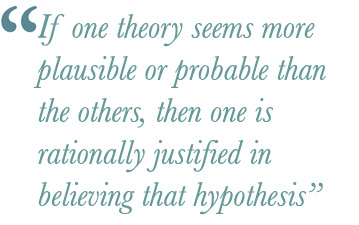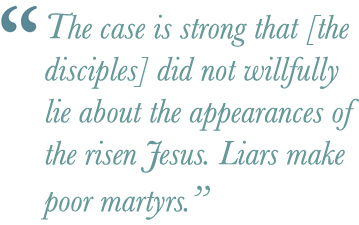David P. Diaz, Ed.D.
In Part 1 of this article, we provided justification for the reliability of the Greek text, the early dating of the creed in 1 Corinthians 15, and put forward other corroborating factors (i.e., early, independent, and multiple historical attestations). Thus, I believe we have good reason to think that the four facts about the early Christians, as identified in Part 1 of this article, are true. Namely, the earliest Christians, some of whom may not have personally witnessed Jesus during his earthly ministry, believed that (1) Jesus died by crucifixion and was buried, (2) certain named individuals had experiences that led them to believe and proclaim that Jesus had risen from the dead, (3) key groups of people had experiences that led them to believe and proclaim that Jesus had risen from the dead, and (4) testimonies of the risen Jesus affirmed that he appeared in bodily form.
Hypotheses that Attempt to Explain the Purported Facts
I think we would all agree that just because people believe something doesn’t mean it’s true. Nevertheless, if you agree that the above four purported facts are probable or even plausible, it begs the question of what best explains why so many of the earliest Christians believed that Jesus was crucified, that he subsequently died and was buried, and on the third day after his burial, he was seen as risen from the dead.
I will present the following argument as an inference to the best explanation. This type of argument does not attempt to prove the resurrection but, instead, aims to find the best, most probable, or most plausible explanation for the beliefs of the early Christians about the resurrection. It is important to note that there may be other hypotheses (or versions of hypotheses) than those that have been presented here. It is the nature of arguments to the best explanation that they don’t always present every possible explanation.
In the end, you may find that none of the hypotheses proposed are convincing enough to sway your beliefs. But keep in mind that the following discussion is not about determining what we can know with certainty, it is about which hypothesis best explains the purported facts. If one supposition seems more plausible or probable than the others, then one is rationally justified in believing that hypothesis, at least until it has been demonstrated to be false, deeply problematic, or until more information is available to influence one’s mind toward a different position. In other words, in the current context, a belief is justified (provisionally) if the evidence favors one hypothesis relative to all others being considered. An inference to the best explanation asks us to use our reasoning processes to determine which hypothesis best explains the facts.
The Resurrection Hypothesis
The traditional Christian position is that Jesus was crucified, died, and was subsequently buried. On the third day, the tomb was found empty because God had raised him physically from the dead (Gal. 1:1; Rom. 10:9). We will call this H1, the Resurrection Hypothesis.
If Jesus was crucified, died, and was buried, and three days later, he was resurrected from the dead, this would serve as the best explanation for why early Christians believed in the resurrection. In other words, if the beliefs about the resurrection by early Christians are true, then H1 is and must be our choice as the best explanation of the proposed facts listed at the beginning of this essay.
It has been shown (see Part 1 of this article) that the New Testament is a reliable document, although each individual passage or wording should be considered separately. The reason that the creed in 1 Corinthians 15 is reliable is partly because the creed is early and may date back to within a couple of years of the crucifixion of Christ, and perhaps even earlier. Thus, it is highly likely that 1 Corinthians 15:3–7 represents the words originally written by Paul. Part 1 of this article also revealed that the crucifixion and death of Jesus are corroborated by multiple independent sources both within and outside the New Testament. Thus, unless some other hypothesis better explains the four proposed facts, then the resurrection seems to be the best explanation for the beliefs of early Christians.
Hallucination Hypothesis
Skeptic biblical scholars Michael Goulder and Gerd Lüdemann think that certain psychological conditions (i.e., hallucinations, delusions, visions, etc.) brought about the experiences of a risen Jesus in some or all of the disciples.[6] Goulder refers to hallucination experiences as “communal delusions”[7] while Lüdemann prefers to describe hallucinations as “nonveridical [i.e., not genuine] visions.”[8]
Hallucinations are private experiences that occur in the minds of individuals. Hallucinations represent a “misattribution of private events.”[9] Thus, they are sensory experiences that do not represent what is real or veridical. Hallucinations are personal, not collective experiences, thus, there is a limited possibility for individual hallucinations to be shared across persons.
Although it is possible that the “power of suggestion” plays a role in reports of a mass witnessing of an event, the diverse characteristics of the resurrection appearances (location, number of witnesses, physical and social environment, etc.) make it less likely that suggestion was a factor. In any case, there is little to suggest that the resurrection appearances were mass hallucinations.
Third, it is understandable why some might believe that certain individuals cited in the New Testament suffered a hallucination. Peter, for example, must have felt guilty for denying Jesus and running away during his arrest and was most likely grief-stricken by the loss of his Master. He was a sincere believer and, therefore, had every reason to want the resurrection to be true. Indeed, Peter was perhaps the perfect candidate for a hallucination. According to one view, Peter purportedly hallucinated Jesus’s appearance and then communicated his experience with other disciples who then shared his hallucination.[10] Nevertheless, although hallucinations could have been at work in a small group of individual believers, it is unlikely that hallucinations accounted for all or even most of the resurrection appearances. Even if one accepts the idea that a “chain reaction” of hallucinations was started by Peter and spread like an infection to the other disciples, this does not explain Jesus’s appearances to James, Paul, and others who stood outside the chain.[11] Neither James, “the Lord’s brother” (see Gal. 1:19), nor Paul was a follower of Jesus during his ministry. Therefore, there is no compelling reason to assume they were in the right frame of mind to experience a hallucination. Paul had no contact with Jesus during his lifetime and would have had no expectations regarding Jesus’s status after his death. Paul was antagonistic to all who promoted and practiced Christianity until his conversion experience, about two to three years after Jesus’s crucifixion (Acts 8:1–3; 9:2). James did not believe in the work of his brother Jesus and stood opposed to him throughout his earthly ministry (Jn. 7:3–5).[12] Others, like Thomas, who doubted Jesus, wouldn’t have been a good candidate for hallucinations due to his observed tendency toward skepticism.
Fourth, the hallucination hypothesis lacks a corpse. If the resurrection appearances were hallucinations, then the belief that Jesus physically appeared could have been easily dismissed by simply producing the corpse of Jesus. But a body was never produced. Moreover, even if some did have hallucinations of Jesus, producing a body most likely would (should?) have disabused them of the notion that Jesus was still alive, and they likely would not have persisted in this belief.
Fifth, the hallucination hypothesis relies on attempts to diagnose hallucinations (or delusions or visions) in people “who are not only absent but who also lived in an ancient foreign culture.” According to Licona, such an exercise “involves a great deal of speculation and is a very difficult and chancy practice.”[13] On what basis could one hope to successfully diagnose first-century Palestinian Jews as hallucinatory? What would make such a diagnosis anything more than mere conjecture?
Apparent-Death Hypothesis
The principal difficulty with this theory is that to be crucified at the time of Jesus and yet not die was an unlikely result. Crucifixion was common in the eastern Mediterranean long before the Romans adopted the method.[14] The Romans, however, turned crucifixion into a deadly art form.[15] Standard practices were: (1) scourging before the crucifixion, (2) the condemned carrying the crossbeam, and (3) guards stationed at the cross until the death of the victim.[16] Other practices included (4) driving nails through the wrist and ankle bones of the victim, (5) crurifragium (breaking the legs to expedite death), and sometimes (6) a final spear thrust to the heart to determine death.[17] There is really no way to know for sure which of these practices applied to Jesus’s crucifixion, although the Gospels cite five of the six mentioned above.
Since crucifixion was a capital punishment, it is reasonable to think that crucified people died from the experience. There is only one account in ancient history where a person was claimed to have survived a crucifixion. Josephus related this occurrence, which took place on an official visit to a village called Thecoa.[18] Upon seeing three former acquaintances in the process of being crucified, Josephus described how he pleaded on their behalf to the Roman commander, Titus, who promptly released them into the immediate care of a physician. Despite this prompt attention, two of the three died, and one recovered. This example shows that crucified victims most likely died, even under the best conditions.
Today, even among agnostic and atheist historians, Jesus’s crucifixion and death are often considered two established facts. According to (agnostic/atheist) New Testament scholar Bart Ehrman, “That Jesus died by crucifixion is almost universally attested in our sources, early and late.”[19] Atheist historian Gerd Lüdemann adds, “Jesus’ death as a consequence of crucifixion is indisputable.”[20] New Testament scholar John Dominic Crossan, who believes that the claim of Jesus’s deity is, at best, a mere metaphor, stated that there is not the “slightest doubt about the fact of Jesus’ crucifixion under Pontius Pilate” and “That he was crucified is as sure as anything historical can ever be.”[21]
Conspiracy Hypothesis
This leads us to a theory that suggests that perhaps Jesus’s body was stolen, either by the disciples or other friends of Jesus. Although conspiracies can take many forms, the current hypothesis will just consider the claim that the dead body of Jesus was surreptitiously removed from the tomb, and the perpetrators successfully covered up their activity. Such duplicity has been espoused by many, from non-religious skeptics to religious Jews. To what purpose might the body of Jesus have been stolen? Could it be that these were grave robbers? What did Jesus have in the tomb that was worth stealing? Surely, not merely his body.
Perhaps we are supposed to believe that the disciples knew that Jesus did not die or rise from the dead and yet, for some unknown reason, they convinced themselves and other early followers to risk their lives, futures, and the fates of their loved ones by preaching the gospel of a risen Jesus who was, in fact, dead. While many people believe untrue things and are willing to risk their well-being and even their lives for something they genuinely believe, it begs the question of why anyone would willingly suffer such widespread risk of abuse for something they knew was a lie.
Eminent New Testament scholar Dale C. Allison Jr. tells us that a duplicity theory requires “conscious deception” on the part of those involved.[22] But to what end? Did the disciples think that if they pirated Jesus’s body, they would gain favor among the Jewish leaders? Did they believe that such a lie would lead them to a rewarding and lucrative vocation for the rest of their lives? Probably not. As Sean McDowell notes: “The apostles proclaimed the risen Jesus to skeptical and antagonistic audiences with full knowledge they would likely suffer and die for their beliefs.”[23] Licona put a fine point on it: “The disciples’ willingness to suffer and die for their beliefs indicates that they certainly regarded those beliefs as true. The case is strong in that they did not willfully lie about the appearance of the risen Jesus. Liars make poor martyrs.”[24] Even if the disciples did not end up dying for their faith, at the very least, they endured public scorn and persecution and risked their lives and the futures of their families. Should we think it likely that they did so while not believing God raised Jesus from the dead?
Perhaps the only version of this hypothesis that would have some hypothetical weight would be if one or more well-meaning followers of Jesus, unbeknownst to the disciples, spirited away Jesus’s body (perhaps to restore his good name?) and kept this fact hidden from the disciples and everyone else. Though some might find this sub-hypothesis acceptable, it seems far-fetched that such a deception, even if carried out by religiously or socially concerned individuals, could have emerged and persisted without the disciples and others finding out. It is unclear what motive would have coerced a group of followers to keep such a fact from the disciples, the family of Jesus, and everyone else. And, if they did inform the disciples and others, then one would have to believe that this conspiracy was carried out and promoted on a wide scale. But to what end? It seems unfathomable.
In conclusion, H4 seems ad hoc and lacks compelling evidence to support its truth. It may be a convenient idea for skeptics, and perhaps this accounts for its popularity, but it lacks supporting facts.
Myth Hypothesis
Some believe that the resurrection was a mythical tale that was constructed long after the events in question. These tales were either concocted by the disciples or were perhaps produced by others after the original followers of Jesus were deceased. However, this doesn’t square with the fact that the creed in 1 Corinthians 15 demonstrates that Christians most likely believed in the death, burial, and resurrection early on, perhaps even weeks or months after the crucifixion. There was simply no time for mythical development. The reliability and early dating of the creed (see Part 1) would severely impact the credibility of any hypothesis that claims that early Christians believed in a mythological story of the resurrection.
Roman historian A. N. Sherwin-White tells us that Herodotus’s tales of the Persian Wars provide us an opportunity “to test the tempo of myth-making.” He concludes, “The tests suggest that even two generations are too short a span to allow the mythical tendency to prevail over the hard historic core of the oral tradition.”[25] The fact that the creed in 1 Corinthians 15 suggests that the resurrection of Jesus was part of the belief system of the earliest Christians suggests that there was not enough time for the development of a mythical tale. Not even one generation had passed before Paul introduced the creed to the Christians at Corinth: “For I delivered to you as of first importance what I also received, that Christ died for our sins according to the Scriptures and that He was buried, and that He was raised on the third day according to the Scriptures” (1 Cor. 15:3–4).
Conclusion
The preceding article listed four facts that find their source in a creed that most likely represents the beliefs of the earliest Christians. Why did so many people develop these beliefs so soon after the crucifixion of Jesus? The earliest Christians believed that Jesus died by crucifixion, was buried, and was resurrected by God. They also believed that he appeared alive to many of his followers within three days of his crucifixion. You may be saying, so what? Why would anyone care if some people believed Jesus appeared to them? Does that make it true? No, it doesn’t. But ask yourself the following question: Which of the previous five hypotheses best explains these early beliefs? The hypothesis that explains more of the evidence than any other is the one that should be believed, at least until a better explanation is available. In other words, it is rational to believe in the best explanation for a set of facts unless or until a defeater of said explanation is produced or unless better explanations cause one to change her view.
In conclusion, I presented four facts that are widely supported, and I offered five possible explanations for the proposed facts. I have not attempted to prove the truth of the resurrection, nor have I claimed to refute every naturalistic hypothesis (I’ve only included those I consider to be the more commonly professed). It is my contention that the facts point to the resurrection hypothesis as the best explanation. If you are reluctant to accept the resurrection hypothesis solely because it requires the existence of God, then perhaps you should reevaluate whether an all-powerful, all-knowing, all-loving Being (i.e., the God of Christian theism) could possibly exist. Plenty of theistic arguments have been put forth to demonstrate God’s existence.
At this point, let me challenge you to pick a horse in the race. If you think that one of the hypotheses (i.e., H1–H5) represents a better explanation of the facts than the others, then run with it. Your decision will not be written in stone. It is simply a judgment reflecting your current thoughts about the options presented. Ask yourself if the naturalistic hypotheses—hallucination, apparent death, conspiracy, or myth—make better sense of the facts. Or does the resurrection hypothesis seem a more plausible explanation? Focus your future studies on whatever hypothesis you choose and test it to be sure it holds water.
In my opinion, the resurrection hypothesis provides a better, more consistent, and coherent explanation for why so many early Christians believed in the resurrection and lived the rest of their lives proclaiming this good news to all who would listen (even to those who would do them harm). If you agree, you can be rationally justified in believing that Jesus rose from the dead unless or until there are other hypotheses that better explain the beliefs of the early Church.
About the Author
David P. Diaz, Ed.D. is an author, retired college professor, and publisher of the Things I Believe Project. His writings have spanned the gamut from peer-reviewed technical articles to his memoir, which won the 2006 American Book Award. Dr. Diaz holds a Bachelor and Master of Science degrees from California Polytechnic State University, a Master of Arts in Philosophical Apologetics from Houston Christian University, and a Doctor of Education specializing in Computing and Information Technology from Nova Southeastern University.
Bibliography
Allison, Dale C. The Resurrection of Jesus: Apologetics, Polemics, History. London, UK: T&T Clark, 2021.
Allison, Dale C. Resurrecting Jesus: The Earliest Christian Tradition and Its Interpreters. New York, NY: T & T Clark, 2006.
Beck, William David, and Mike Licona, eds. Raised on the Third Day: Defending the Historicity of the Resurrection of Jesus. Lexham Press, 2020.
Craig, William Lane. Assessing the New Testament Evidence for the Historicity of the Resurrection of Jesus. Edwin Mellin Press, 1989.
Craig, William Lane, and Lüdemann, Gerd. Jesus’ Resurrection: Fact or Figment?: A Debate between William Lane Craig & Gerd Lüdemann. Edited by Paul Copan and Ronald K. Tacelli. InterVarsity Press, 2000.
Ehrman, Bart D., and Daniel B. Wallace. The Reliability of the New Testament. Edited by Robert B. Stewart. Minneapolis, MN: Fortress Press, 2011.
Ehrman, Bart D. Did Jesus Exist?: The Historical Argument for Jesus of Nazareth. New York, NY: HarperOne, 2013.
Ehrman, Bart D. The New Testament: A Historical Introduction to the Early Christian Writings. 7th ed. New York, NY: Oxford University Press, 2020.
Evans, Craig A. Fabricating Jesus: How Modern Scholars Distort the Gospels. Downers Grove, IL: IVP, 2007.
Gundry, Robert H. A Survey of the New Testament. Grand Rapids, MI: Zondervan, 2012.
Gurry, Peter J., and Elijah Hixson. Myths and Mistakes in New Testament Textual Criticism. Downer’s Grove, IL: IVP Academic, 2019.
Habermas, Gary R., and Mike Licona. The Case for the Resurrection of Jesus. Grand Rapids, MI: Kregel Publications, 2004.
Holoubek, Joe E., and Alice Baker Holoubek. “A Study of Death by Crucifixion with Attempted Explanation of the Death of Jesus Christ.” The Linacre Quarterly 61, no. 1 (1994): 10–19. https://doi.org/10.1080/20508549.1999.11878236.
Johnson, Luke Timothy. The Writings of the New Testament: An Interpretation. Minneapolis, MN: Fortress Press, 2010.
Josephus, Flavius. The Works of Josephus: Complete and Unabridged. Translated by William Whiston. Peabody, MA: Hendrickson Publishers, 2018.
Keener, Craig S. Miracles: The Credibility of the New Testament Accounts. Grand Rapids, MI: Baker Academic, 2011.
Kennedy, D. James, and Jerry Newcombe. What If Jesus Had Never Been Born?: The Positive Impact of Christianity in History. Nashville, TN: Nelson Publishers, 2001.
Kruger, Michael J. Christianity at the Crossroads: How the Second Century Shaped the Future of the Church. Downers Grove, IL: InterVarsity Press, 2018.
Licona, Michael R. The Resurrection of Jesus: A New Historiographical Approach. Nottingham: Apollos, 2010.
Licona, Michael R. “Historians and Miracle Claims.” Journal for the Study of the Historical Jesus 12, no. 1-2 (2014): 106–29. https://doi.org/10.1163/17455197-01202002.
Lipton, Peter. Inference to the Best Explanation. Routledge Taylor & Francis Group, 2010.
Loke, Andrew. Investigating the Resurrection of Jesus Christ: A New Transdisciplinary Approach. New York and London: Routledge, 2021.
McDowell, Sean. The Fate of the Apostles: Examining the Martyrdom Accounts of the Closest Followers of Jesus. London, UK: Routledge, 2018.
Sherwin-White, A. N. Roman Society and Roman Law in the New Testament. Eugene, OR: Wipf and Stock, 2004.
Wallace, Daniel B., ed. Revisiting the Corruption of the New Testament: Manuscript, Patristic, and Apocryphal Evidence. Grand Rapids, MI: Kregel, 2011.
Wright, N. T. The Resurrection of the Son of God. Minneapolis, MN: Fortress Press, 2003.
Wright, N. T., and Michael F. Bird. The New Testament in Its World: An Introduction to the History, Literature, and Theology of the First Christians. London: SPCK, 2019.
Footnotes
[1] A naturalistic hypothesis is one that does not appeal to supernatural causes.
[2] Andre Aleman and Frank Larøi. Hallucinations: The Science of Idiosyncratic Perception. Washington, DC: American Psychological Association, 2008, Kindle location 1276.
[3] This is especially true in older adults who have recently lost a close loved one. See the 1991 study by Tien in Aleman and Larøi (2008), Kindle location 1261.
[4] Such a high figure is entirely speculative and is, thus, ad hoc. There is no evidence for the prevalence of hallucinations in the first century, but it seems far-fetched to think that such psychotic episodes were more common than 50 percent.
[5] APA Dictionary of Psychology, Accessed April 26, 2022. https://dictionary.apa.org/hallucination. Though not everyone defines hallucinations in the same way, for our purposes, hallucinations lack an external object of perception. In this sense, a hallucination would be different from a vision or an illusion.
[6] As cited in Licona, The Resurrection of Jesus, chapter 5.
[7] Ibid., 479–82.
[8] As cited in William Lane Craig and Gerd Lüdemann, Jesus’ Resurrection: Fact or Figment?: A Debate between William Lane Craig & Gerd Lüdemann, ed. Paul Copan and Ronald K. Tacelli (InterVarsity Press, 2000), Kindle location 2049.
[9] Aleman and Larøi, Hallucinations, Kindle location 2185.
[10] Lüdemann as cited in Licona, The Resurrection of Jesus, 498.
[11] William Lane Craig, Assessing the New Testament Evidence for the Historicity of the Resurrection of Jesus (Edwin Mellin Press, 1989), 289.
[12] Habermas and Licona, The Case for the Resurrection, 285, n21, 22.
[13] Licona, The Resurrection of Jesus, 505.
[14] Craig A. Evans, Jesus and the Remains of His Day: Studies in Jesus and the Evidence of Material Culture (Peabody, MA: Endrickson Publishers Marketing, 2015), 163.
[15] For the gruesome nature of scourging and other physical aspects of the resurrection, see William D. Edwards, Wesley J. Gabel, and Floyed E. Hosmer, “On the Physical Death of Jesus Christ,” JAMA 255, no. 11 (1986): pp. 1455-1463, https://doi.org/10.1001/jama.1986.03370110077025.
[16] Evans, Jesus and the Remains of His Day, 164–65.
[17] Joe E. Holoubek and Alice Baker Holoubek, “A Study of Death by Crucifixion with Attempted Explanation of the Death of Jesus Christ,” The Linacre Quarterly: Vol. 61: No. 1, Article 3 (1994): pp. 10–19. https://epublications.marquette.edu/lnq/vol61/iss1/3.
[18] Josephus, The Life of Flavius Josephus, 76.420–21.
[19] Bart D. Ehrman, Did Jesus Exist?: The Historical Argument for Jesus of Nazareth (New York, NY: HarperOne, 2013), 163.
[20] As cited in Licona, The Resurrection of Jesus, 311.
[21] Ibid., 311–312.
[22] Dale C. Allison, The Resurrection of Jesus: Apologetics, Polemics, History (London: T&T Clark, 2021) 15.
[23] Sean McDowell, The Fate of the Apostles: Examining the Martyrdom Accounts of the Closest Followers of Jesus (London, UK: Routledge, 2018), 264.
[24] Licona, The Resurrection of Jesus, 370.
[25] A. N. Sherwin-White, Roman Society and Roman Law in the New Testament (Eugene, OR: Wipf and Stock, 2004), 190.




